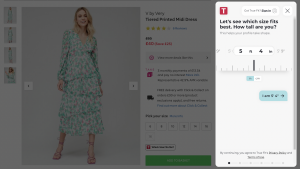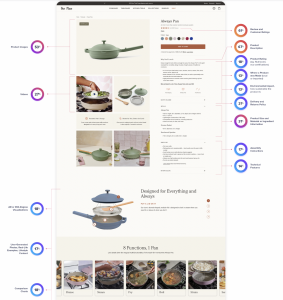By Carla El Gawly, Retail Strategy & Partnerships Director, EMEA at Salsify
The Omnichannel Digital Touch
Has your ecommerce performance experienced the “slower-growth new normal”, as eMarketer calls it in its Global Retail Ecommerce Forecast 2023?
Even if growth trends slowed down, while the split between ecommerce and physical retail in the UK was 21.8% and 78.2% in 2019, by 2025 ecommerce will account for 38.6% of total retail sales in the UK (excluding travel and food). The UK is the most advanced ecommerce market in Europe according to statista, and has the highest proportion of digital buyers (80%) among the population.
Whether the shopping journey happens online or in-store: digital touch points are omnipresent anytime, everywhere – and on-site shopping journeys are more and more shaped by digital experiences as recent surveys and market analysis has shown over the past years, predicting over half of in-store sales being digitally influenced in Europe.
Product Content Is Key
For consumers worldwide the quality and quantity of product content is key when deciding where to buy and what to purchase online. More than half of over 6,300 consumers surveyed in Salsify’s consumer research wouldn’t buy a product because of bad product content that doesn’t include enough information or includes low-quality product images. Shoppers are more likely to purchase products from unfamiliar brands or those with bad reputations than those with missing relevant product information.
Source: Salsify’s Consumer Research 2023
Turn Product Pages Into Brand Experiences
Getting the most out of each product page goes with extending product pages beyond basic information – to ultimately capture more consumer attention and drive brand loyalty, leading to increased conversion rates. 68% of UK shoppers consider product descriptions as the most important element on a product page when deciding what to buy – followed by consumer reviews (65%) and product images (53%).
If product pages don’t provide the information consumers are looking for, they go elsewhere to learn more about the product – and the retailer site loses its potential customer to competitors who provide a richer customer experience on their product pages. 64% of UK customers are loyal to brands because of the online product experience.
Key Elements Of An Effective Product Page Strategy
The physical product experience in brick-and-mortar stores can’t be the same on the digital shelf. However, a product page strategy that focuses on a few core practices for digital shelf success can help retailers and brands bring their products to life. Four key elements are useful to build an engaging product page to vest support consumers purchase decisions:
#1: Copywriting
You’re a retailer or a brand, but thinking like a customer could facilitate building product pages that reflect shoppers needs and expectations of the latter. Using descriptive language can best inform customers – words associated with strong feelings, such as “silky,” “delicious,” “soft,” and “sharp” for example. Beyond that, to win on the digital shelf, prioritising SEO and updating keywords in line with search algorithms should be a core part of your strategy. In fact, Amazon is where shoppers are most likely to research and compare products before buying – next to search engines and in-store. To be visible to consumers in this pre-purchase process, you can include keywords that will help your products show higher up on the product listing page. The easier it is for shoppers to find your product, the more likely they are to buy it.
Another important side-effect of comprehensive correct product descriptions is the reduction of return rates.
Statista revealed ‘wrong size’ as the main reason for returning online purchases for 66% of consumers in the UK. Precise size and fit information is particularly important for shoppers of apparel items, this can be done via fit technology, detailed size guides, and return-related recommendations. An example from Very.co.uk through their partnership with Truefit supports customers through a series of questions to recommend the right size.

To reduce returns and encourage customers to carefully check product details, Amazon now adds a tag on PDPs to warn customers about ‘frequently returned items’ where applicable.
The most basic of product descriptions should always include:
- The product’s features and technical details
- The product’s composition
- The benefits of using the product
- Instructions for using the product
- Warranty information
- Other important product information
#2: Product Visuals
Text is key because it can give consumers very detailed information about everything the product offers. But text alone won’t make you win on the digital shelf. Even top-notch copywriting needs to be paired with visuals, e.g. product images, videos, and graphics.
Product images can show what the product looks like in a particular setting or context, may this be in a kitchen or a garden, for example. Interactive image galleries are particularly appreciated by shoppers as they can enlarge them and scroll through.
Videos illustrate the product’s features or show customers how to use the product. The average basket size increases by at least 50% when shoppers watch a video on a product page! Therefore, try embedding at least one video onto each product page whenever possible.
Enhanced content helps to highlight your brand and product story. It demonstrates your commitment to making quality products, highlights what makes those products special, and shows the product features that customers love and look for. User generated content, video testimonials, and FAQs will further enrich the product experience for shoppers. You can find more concrete examples in Salsify’s Complete Guide to Building Winning Shopping Experiences.
#3: Interactive Elements
Conventional product pages include product descriptions, images, and in many cases also a video. However, optimised product pages go beyond these and include interactive experiences. These can be comparison charts that demonstrate a product’s performance or specific features compared to similar products or other products in the same range.
Videos of people unboxing a package show customers’ excitement for the product, as well as the package’s contents, such as any additional elements, like screws for a do-it-yourself item, or batteries provided with a torch. All these content elements help bridge the gap between not holding the product in your hands while shopping online and still being able to make a product experience before buying it, which ultimately stimulates the shopper’s choice.

Lego Enhanced content showing product features and video content
#4: User Generated Content
The opinion of peers undoubtedly influences other customer’s buying decisions. Collecting review content can drive valuable insight for your business. Positive reviews indicate what people like about your product, neutral or negative could help you understand if any information is missing or what could be done to improve a product, or adapt the information you provide e.g. does the product image not look like the item? Is an important attribute not highlighted?

Lego “Fan Moments” from their customers made up of UGC images collected through social media campaigns
Question and Answers features allow shoppers to see what other customers are asking and perhaps reduce the resource you spend on answering common queries. This gives you useful pointers on what product information may be missing that generates an ask from your customers. User generated content is often text reviews/Q&A but also images or videos of using a product.
Reading or seeing someone else’s experience with the product is a great alternative when you are not in front of the physical product or speaking experts on-site. Consumers are more than ever researching products online and buying offline (ROBO) meaning your online PDP can also influence consumer purchase decisions in your physical stores.
The more information a customer has about your product, through reviews of all sentiment supports a reduction in returns. GANT has attributed a reduction in its return rates by 5% to product reviews, whilst having observed significantly increased sales.
In Practice: What Feature Of A Product Page Helps Shoppers Most When Deciding What To Buy Online?
Over 6,300 consumers surveyed in Great Britain, Germany, France, the US and Australia indicated what they prioritise when making purchasing decisions that you can see in the infographic below.

Best Practices For Best Possible Product Pages
Following best practices for product pages help foster positive shopping experiences for consumers on the digital shelf:
- Highlight the product’s key features and advantages.
- Provide detailed headings and product descriptions.
- Use less text and more visuals.
- Keep content precise and concise.
- Use well-thought-out language.
- Include consistent brand stories.
- Highlight customer reviews and UGC
- Chose tech partners whom can deliver commercial goals around content optimisation
- Stay connected with your shoppers.
- Test – then test again.
A product page is never truly static. As seasonal changes take place, new products are released from your brand or competitors, or as consumers themselves shift their focus – adapting product pages accordingly goes with it. By adopting a practice of evaluating your market and the performance of your pages as well as investing in a process to keep them regularly updated, you will more likely maintain growth even in the face of a slower-growth new normal for all of retail.
Published 10/05/2023


